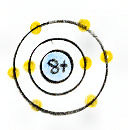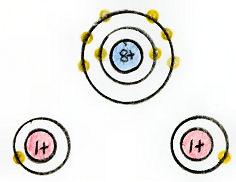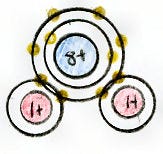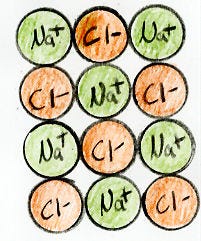Cholesterol is a molecule. All molecules are made of atoms. From the structure of an atom to the covalent bonds of a water molecule, if it's all Greek to you, keep reading! Sit tight... you are about to quickly master the basic concepts of chemistry...
The Atom
Atoms are considered to be the most basic and fundamental particle of matter. They are made of positive, negative, and neutral charges. The positive charges are called protons. The negative charges are called electrons. Finally, the neutral charges are called neutrons.
One of the basic tendencies of nature is the tendency toward electric neutrality. That's a fancy way of saying that nature prevents the building up of positive and negative charges in one spot by balancing them out. In order for this balancing to occur, there are two laws:
like charges repel each other.
opposite charges attract.
The result? Atoms! Atoms contain equal numbers of positive and negative charges. So the number of protons in an atom is equal to the number of electrons. Since neutrons are not charged, the number of neutrons can vary.
The picture below is a model of oxygen, which shows how these particles are arranged in the structure of an atom.
In the figure shown above, the protons and neutrons are clustered together in the center of the atom, thenucleus. The electrons are shown orbiting around the nucleus. Electrons behave more like a cloud surrounding the atom, but the picture shows individual particles to make the concepts easier to understand.
Oxygen has eight protons and eight electrons. Electric neutrality! Its number of neutrons doesn't affect the charge, so it will vary.
Remember that one oxygen in the cholesterol molecule? Keep it in mind as we move along...
Notice that the electrons are arranged in different shells. The inner shell contains two, and the outer shell contains six. Most shells are considered to be full when they contain eight electrons, but the first shell always fills up with only two.
So, an atom like sodium that has 11 electrons will have a third shell. The first would contain two, the second eight, and the third one. An atom like hydrogen, which contains only 1 electron, would have only the first shell.
Regardless of how many shells there are, the outer shell of each atom is called the valence shell. Keep this in mind when we discuss covalent bonds!
Nature Always Fills the Valence Shell
Do you remember what the first tendency of nature was that we discussed?
Right... a tendency toward electric neutrality.
Let's add one more: the tendency toward a full valence shell. Some atoms naturally have a full valence shell. Most atoms do not. For those atoms that do not have a full valence shell (which usually would contain eight electrons, except for hydrogen and helium, where it would contain two), something has to change.
So nature's tendency toward a full valence shell will lead to one of two things:
The gain or loss of electrons
Covalent bonding
We'll discuss covalent bonds first.
Covalent Bonds Make Molecules
The cholesterol molecule is made of covalent bonds. All molecules are made of covalent bonds. Since the cholesterol molecule is so large and complicated, we'll use the water molecule as our example.
Do you recognize any terms you just learned within the word "covalent"?
Covalent = Co - valent
A covalent bond is a bond where two atoms share part of their valence shell. This is one of nature's ways of satisfying the tendency toward a full valence shell.
Consider the picture below, which shows an oxygen and two hydrogens, which are the atoms that make up the water molecule.
Notice that none of the three atoms above have full valence shells. How many electrons does the oxygen need to make its outer shell full? Each hydrogen?
The oxygen needs eight electrons total in its outer shell, and it has six, so it needs:
8-6= 2 electrons.
The hydrogen needs two total in its outer (only) shell, and it has one, so it needs:
2-1= 1 electron.
Say you and a friend both wanted to start a similar type of business, but neither could raise the startup cash on your own. What would you do? Pool your resources together! Your friend gets to go in business despite only having part of the money she needed to start, and you do as well.
This is exactly what the two hydrogens and the oxygen do. If the first hydrogen shares one of its electrons with the oxygen, in exchange for the oxygen sharing one of its electrons with the same hydrogen, the hydrogen's valence shell will be full (with two), and the oxygen's will be one step closer to being full (with seven.)
A second hydrogen sharing in the same way will fill its own valence shell (with two), and will complete oxygen's (with eight.) Thus, a water molecule is born!
The picture of a water molecule below hits this lesson home:
In the figure above, the hydrogen on the left and oxygen share two electrons together. One came from the hydrogen, one from the oxygen. The hydrogen on the right does the same. The other six electrons on the oxygen belong to the oxygen alone.
Since water is made of covalent bonds, it is a molecule. Not all chemical bonds make molecules though. Keep on reading to find out why...
But first, let's quickly recap:
There are two tendencies in nature:
the tendency toward electric neutrality
the tendency toward a full valence shell
The tendency toward electric neutrality results in atoms, which contain an equal balance of positive and negative charges.
The tendency toward a full valence shell results in covalent bonds, in which two atoms pool their electrons together and share part of their valence shells so they both end up with full outer electron shells.
But there is one other way that atoms can achieve a full valence shell...
Ionic Bonding
When two atoms pool their electrons together in a covalent bond, they both wind up with more electrons in their valence shell. But take a look at the structure of the sodium atom below.
Sodium has 11 electrons: two in its inner shell, eight in its second shell, and one in its valence shell. Unlike the oxygen, which was able to fill its valence shell with only two electrons, sodium would have to gainseven!That's a lot of work!
Take a closer look. Do you see an easier way to gain a full valence shell? Remember, any of the shells can be the valence shell, as long as it is the outmost shell.
It would be much easier to just lose one electron than to gain seven. So the easiest way is to just get rid of the one electron on the outside, and the already-full shell underneath it becomes the valence shell!
But where would the electron go?
...Simple. It would have to find an atom that wanted to gain one electron. The picture below shows the structure of the sodium and chlorine atoms, and the transfer of the lone electron. This is a special type of reaction called an oxidation-reduction reaction.
Oxidation is the loss of an electron. Reduction is the gain of an electron. The picture above shows the sodium atom becoming oxidized and the chlorine atom becoming reduced. Another way to say this is that sodium reduces chlorine and chlorine oxidizes sodium.
Uh-oh.
Now that we've satisfied nature's tendency toward a full valence shell, do you see what's happened? Now sodium and chlorine both have different numbers of electrons and protons! We've disturbed nature's first rule:
the tendency toward electric neutrality
Remember, the atoms were made in the first place to balance the positive and negative charges. Now that sodium has lost an electron, it has a positive charge. Now that chlorine has gained an electron, it has a negative charge. Neither are neutral any more.
Something must change.
An atom with a different number of protons and electrons is called an ion. If the atom has more electrons than protons, it is a negative ion,. If it has more protons than electrons, it is a positive ion.
Ions disturb nature's tendency toward electric neutrality. In response, nature forms the ionic bond.
Remember that opposite charges attract? Since the sodium is now positive, and the chloride (the name for ionic chlorine) is now negative, they become attracted to each other. They stick together tightly, but each has its own electrons. There is no valence sharing.
Sodium and chlorine now become sodium chloride... table salt!
Since there is no valence sharing, there is no covalent bond. Since there is no covalent bond, there is no molecule. There is no such thing as a "molecule of salt"! Instead, ionic bonds like those within salt form crystals...
What Makes a Molecule a Molecule
The picture of water molecules below shows how the molecules would be arranged in, say, a glass of water.
The solid black lines above indicate a covalent bond. The dotted lines show weak bonds between the hydrogen (red) of one water molecule and the oxygen (blue) of another. These bonds are very different from covalent bonds and are fleeting. They are constantly being broken by the movement of water molecules. For a further explanation, see the lesson on the hydroxyl group.
Notice that every single water molecule has the exact same number of hydrogens, and the exact same number of oxygens. Each molecule has one oxygen and two hydrogens. We designate this "molecular formula" as H2O.
While the water molecules are attracted to each other, the attraction is an entirely different kind of bond from the bonds within the water molecule. Each molecule is a distinct entity.
Now look at the next picture, which shows the structure of a salt crystal. Notice that the bonds between all of the atoms are the same kind.
In the salt crystal, sodium chloride, or NaCl, has one atom of sodium (Na+) for every atom of chlorine (Cl-). But as long as this ratio stays constant, you can have as many or as little atoms as you like, and you still have sodium chloride — you still have table salt.
This is why we don't call ionic compounds "molecules." There is no distinct unit. A crystal can be big or small.
A molecule is defined by the precise number of each atom within it. H4O2 is not water. The bonds within a molecule never occur between molecules.
An ionic compound is defined by the ratio of atoms within it. The precise number doesn't matter. NaCl is sodium chloride and Na100Cl100 is sodium chloride. A whole crystal has the same type of bond between every atom, so the type of bond can't distinguish any sub-unit as a "molecule."
Cholesterol is a Molecule
Cholesterol is a molecule. Each atom within it is covalently bound to another. It does not contain ionic bonds. Cholesterol does, however, contain a special type of covalent bond called a polar covalent bond. So does water.
Interested? More on that in the next lesson...








